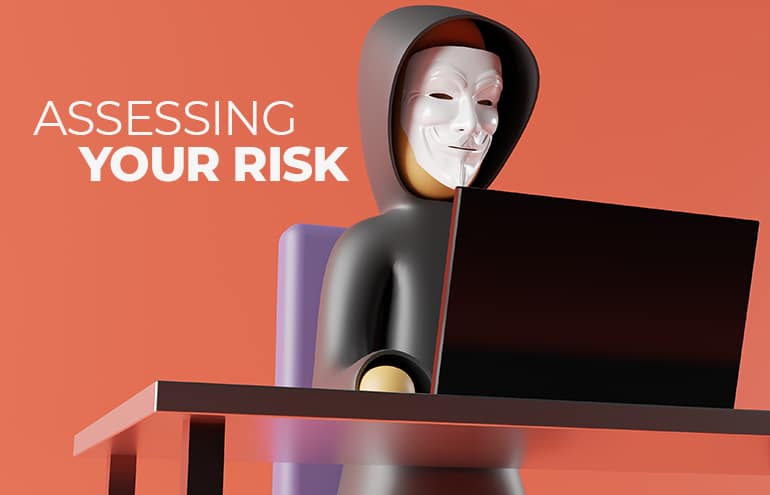A cybersecurity risk assessment isn’t simply about identifying what could go wrong, it’s about taking concrete steps to prevent those things from happening.

Table of contents
Let’s imagine that a thriving law firm, known for its commitment to clients and community, suddenly finds itself in the crosshairs of a cybercriminal. One unsuspecting click on a seemingly harmless email and the firm’s entire client database is encrypted. The hacker demands a ransom in Bitcoin, and the clock is ticking.
The firm’s decision-makers face an impossible choice: pay the ransom and hope for the best or refuse and risk losing everything. This nightmare scenario is not a work of fiction but a harsh reality for many law firms today.
Conducting a Cybersecurity Risk Assessment
So, why should you care about cybersecurity as a law firm? In our interconnected world, conducting a cybersecurity risk assessment for law firms is not just a technical concern; it’s about protecting your clients, your reputation, and your livelihood. According to the American Bar Association’s 2022 Tech Survey, 27% of law firms have experienced data breaches.
Let’s dive into a step-by-step guide that can help you avoid becoming the next victim.
Step 1: Identify Your Law Firm’s Assets and Data
First things first: What’s at stake? Think about the treasure trove of sensitive information you hold:
- Client Information. Imagine if your clients’ personal details were exposed. How would that affect your firm’s reputation? A breach of client confidentiality could lead to legal liabilities, loss of trust and a damaged reputation that may take years to rebuild. It’s not just about data; it’s about the relationships you’ve nurtured.
- Financial Records. What if your firm’s financial integrity was compromised? Financial data is a goldmine for cybercriminals. Unauthorized access to your bank accounts, billing information or investment strategies could lead to financial loss and regulatory scrutiny. It’s about safeguarding the financial health of your firm.
- Employee Data. How would your team feel if their personal information was stolen? Employee data breaches can lead to identity theft and fraud. Protecting this information is a legal obligation and a matter of trust between your firm and your team. It’s about creating a secure environment where your team feels valued and protected.
- Intellectual Property. What about the legal strategies you’ve worked hard to develop? Intellectual property — proprietary research, legal strategies, unique methodologies — is the lifeblood of a law firm. If leaked, it could give competitors an unfair advantage or be used maliciously. It’s about preserving your competitive edge.
By identifying and understanding the value of these assets, you’re laying the foundation for a robust cybersecurity strategy.
Cybersecurity is not just about preventing a data breach; it’s about protecting what makes your law firm unique and successful.
Step 2: Identify Threats and Vulnerabilities
Now, let’s talk about what could go wrong. Remember the story at the beginning of this article? That law firm fell victim to a ransomware attack. Here’s what you need to watch out for:
- Phishing Scams: Those tricky emails that look so real.
- Malware and Ransomware Attacks: The digital equivalent of a Trojan horse.
- Insider Threats: Sometimes, the danger is closer than you think.
- Physical Security Breaches: Yes, even a stolen laptop can spell disaster.
Step 3: Assess Current Controls
So, what’s stopping these threats? Let’s look at your law firm’s defenses.
- Network Security. Your digital fortress. Think of this as the walls and moat around your castle. Firewalls, encryption, secure VPNs and intrusion detection systems work together to keep unauthorized users out and protect your valuable data.
- Password Policies. The keys to the kingdom. Passwords are often the first line of defense, but they’re only as strong as your policies. Enforcing complex passwords that are changed regularly and never reused can make it much harder for cybercriminals to gain access.
- Data Backup and Recovery. Your safety net. If the worst happens and data is lost or encrypted by ransomware, having a robust backup and recovery plan can be a lifesaver. Regular backups to secure offline locations ensure you can restore your systems and return to business.
- Team Training. Because your team is your first line of defense. Human error is a leading cause of security breaches. Training your team to recognize phishing attempts, use secure practices, and report suspicious activity can turn them from potential weak links into valuable assets in your security strategy.
By understanding and implementing these key defenses, you’re taking significant steps to protect your law firm from the ever-present threats in the digital landscape.
It’s about building layers of protection that guard against various types of cyberattacks.
Step 4: Create a Cybersecurity Action Plan
Time to take action. Here’s how to turn your cybersecurity assessment into a battle plan.
- Identify Actions. What needs to be done? This involves pinpointing specific measures to mitigate each identified risk. For example, if phishing is a major concern, implementing email filtering and verification might be an action. It’s about translating the theoretical risks into practical steps.
- Prioritize Actions. What’s most urgent? Not all actions are equally critical. Assessing each risk’s potential impact and likelihood helps you decide what needs immediate attention. For instance, addressing a vulnerability in client data protection might take precedence over updating employee training materials. It’s about focusing your resources where they’ll make the most difference.
- Assign Responsibility: Who’s on it? A plan is only as good as its execution, and that requires clear ownership. Assigning specific team members or departments to each action ensures accountability. Whether it’s the IT department handling network security or HR overseeing team member training, clear roles and expectations are key to success.
You’re creating a structured and actionable plan by breaking down the process into these three steps. It’s not just about identifying what could go wrong; it’s about taking concrete steps to prevent those things from happening. It’s a proactive approach that puts you in control of your firm’s cybersecurity destiny.
Protecting What Matters
Conducting a cybersecurity risk assessment isn’t just a good idea; it’s necessary for any law firm that values its clients and reputation.
In a world where 1 out of 40 cyber-attacks target law firms or insurance providers, can you afford not to take this seriously? Follow this guide and protect what matters. You’ll sleep a little easier!
Photo by GuerrillaBuzz on Unsplash

Sign up for Attorney at Work’s daily practice tips newsletter here and subscribe to our podcast, Attorney at Work Today.
















